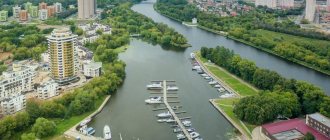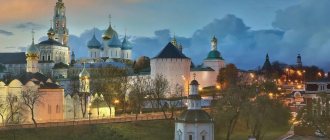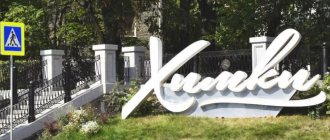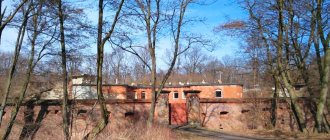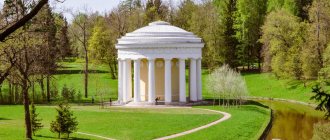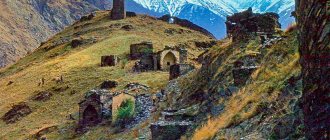This term has other meanings, see Aprelevka (meanings).
| City Aprelevka Flag | Coat of arms |
| A country | Russia, Russia |
| Subject of the federation | Moscow regionMoscow region |
| Municipal district | Naro-Fominsk |
| urban settlement | Aprelevka |
| Coordinates | 55°32′00″ n. w. 37°03′00″ E. long / 55.53333° north w. 37.05000° E. d. / 55.53333; 37.05000 (G) [www.openstreetmap.org/?mlat=55.53333&mlon=37.05000&zoom=12 (O)] (Z)Coordinates: 55°32′00″ N. w. 37°03′00″ E. long / 55.53333° north w. 37.05000° E. d. / 55.53333; 37.05000 (G) [www.openstreetmap.org/?mlat=55.53333&mlon=37.05000&zoom=12 (O)] (I) |
| Chapter | Tamarkin Vitaly Alekseevich |
| Based | 1899 |
| City with | 1961 |
| Square | 29 [1][not in the source ]K:Wikipedia:Articles without sources (type: not specified) km² |
| Center height | 190 |
| Population | ↗25,205[2] people (2016) |
| Names of residents | Aprilevtsy, Aprilevets, Aprilevchanka |
| Timezone | UTC+3 |
| Telephone code | +7 496 345 |
| Postal codes | 143360, 143362, 143363, 143369 |
| Vehicle code | 50, 90, 150, 190, 750 |
| OKATO code | [classif.spb.ru/classificators/view/okt.php?st=A&kr=1&kod=46238502 46 238 502] |
| Official site | [www.aprelevka.rf elevka.rf] |
| Aprelevka |
| Moscow Naro-Fominsk Aprelevka |
| Naro-Fominsk Aprelevka |
K: Settlements founded in 1899
Aprelevka
- a city in Russia (since 1961) in the Naro-Fominsk district of the Moscow region [3]; the largest settlement of the municipal formation "urban settlement of Aprelevka"
The population of the city is 25,205[2] people. (2016).
Aprelevka is located on the banks of the Desna River[3], 42 km southwest of the city of Moscow and 28 km northeast of the city of Naro-Fominsk[4]. Railway station on the Moscow - Kaluga line of the Moscow Railway.
Content
- 1. History
- 2 Population
- 3 Economics
- 4 Transport 4.1 Railway
- 4.2 Buses
- 4.3 Cars
- 5.1 Demidov estate
- 8.1 Video
Comfort level of the city of Aprelevka 13.5 out of 20
| Environmental characteristics | ||
| Green areas | 5 | 4.0 |
| Reservoirs | 4 | |
| Absence of serious sources of anthropogenic pollution | 4 | |
| Visual environment | 3 | |
| Connectivity of the city/region | ||
| Ease of movement within the city/region | 4 | 3.8 |
| Accessibility of Moscow by public transport | 4 | |
| Accessibility of Moscow by personal transport | 4 | |
| Communication with other localities | 4 | |
| Conditions for working within the city | 3 | |
| Social infrastructure | ||
| Kindergartens | 3 | 4.0 |
| Schools | 4 | |
| Children's leisure centers | 5 | |
| Cultural institutions | 4 | |
| Healthcare | 4 | |
| Sports and fitness | 5 | |
| Religious buildings | 3 | |
| Shopping and entertainment infrastructure | 4 | |
| Habitat quality | ||
| State of city utilities | 3 | 2.7 |
| Development of the real estate market | 4 | |
| Parking | 2 | |
| Accessibility for the disabled | 2 | |
| Risks and threats | ||
| Deteriorating transport situation | -1 | -1.0 |
| Underdevelopment of social infrastructure | -1 | |
| Deterioration of the environmental situation | -1 | |
| Oversaturation of the real estate market | -1 | |
Read more:
Where to work for residents of Aprelevka Ecological situation in Aprelevka How much does secondary housing cost in Aprelevka? Spring in Aprelevka and other new buildings
Story
On September 27, 1899, the Aprelevka station of the Moscow-Kiev-Voronezh Railway was opened. The name of the station was given by the Aprelevka estate, which belonged to the writer Nikolai Nikolaevich Zlatovratsky (1845-1911), and the estate, in turn, was named after the Aprelevka river. The river has been on the map since 1850. In the past, the river was called Oprelovka, Aprelovka, the name is associated with the word “ripe”[5].
In 1899, landowner O. S. Dubovich founded a brick factory. In 1910, German industrialists Gottlieb (Bogdan) Moll, Albert Vogt and August Kibert built a factory for the production of gramophone records, Metropol-Record. In 1918, the factory was nationalized and renamed Aprelevsky.
In 1935, Aprelevka was given the status of a workers' village. In 1961, Aprelevka became a city of regional subordination[6].
In 2004, the village of Mamyri and the village of Frunzevets were included in the city[7].
In 2005, in connection with the reform of local government, the city of Aprelevka became the center of the municipal formation “Urban Settlement Aprelevka”[8].
The urban settlement of Aprelevka was formed in 2005 into a territorial composition that included the villages: Afineevo, Pershino, Martemyanovo, Kromino, Khlopovo, Timonino, Malye Gorki and Sanniki. By that time, Mamyri and the village of Frunzovets were already part of this city. The established village of Frunzovets was previously popularly called simply “Dachi of the General Staff”. The land for dachas here has been developed for a long time and has been favored by artists of the Bolshoi Drama Theatre, among others. Meanwhile, the Dachnaya railway platform located nearby was previously called Ketritsa. This is exactly its name that is indicated in the reference book “Settled areas of the Moscow province for 1912”, 1911 edition. We will return to the history of the Ketritsa platform, but for now we will continue the story about Aprelevka.
The oldest settlement of this settlement is Afineevo, mentioned in the Spiritual Charter of Ivan Kalita, containing the lines: “... what I bought from Athenaeus, I give to my son Ivan.” And Kalita’s son, Prince of Moscow and Grand Duke of Vladimir Ivan the Red, will write in his spiritual letter: “And the village of Afinevskoye to Prince Ivan.” From the “Country Tithe” of the Kholmogorov brothers, published in 1884, it is known that in Afineevo there was the estate of “Ivan Patrikeev, son of Milyukov.” Subsequently, it became the dowry of his daughter Marya. In 1627, the Afineevo wasteland on the Malaya Pakhra River was the landholding of Pyotr Stepanovich Korsakov, who built a manor house here and settled peasants. But then he mortgaged the estate in Afineevo to Pyotr Danilovich Protasyev, who became its next owner in 1646. Well, in 1671, his son Alexander began to own the estate of Pyotr Danilovich, followed by his grandson, the okolnichy Mikhail Alexandrovich Protasyev. Mikhail Alexandrovich in 1704 began to build the now existing stone Church of the Beheading of John the Baptist with the chapel of St. Alexei, Metropolitan of Moscow. And five years later it was built and consecrated in 1709. The daughter of Mikhail Alexandrovich, Lyubov Mikhailovna, having married Pyotr Afanasyevich Yushkov, received Afineevo as a dowry. But in 1761 she sold this village to Anna Semyonovna, the wife of Ivan Mikhailovich Volynsky. From Anna Semyonovna Afineevo passes to her son Yegor, and then goes to her grandson, who began the construction of a manor house in the village, connected to the church. At the turn of the 18th-19th centuries, the Moscow leader of the nobility Ivan Vasilyevich Stupishin began to own the village of Afineevo. Under him, the estate expanded and was developed: ponds with artificial islands connected to each other were created, a linden park was planted, and the road to Moscow was lined with birch trees. Stupishin added a bell tower and porticoes to the church.
Until 1839, Afineev was owned by journalist, writer, collector and publisher Pavel Petrovich Svinin. A great lover and collector of Russian antiquities, as well as objects of art, he managed to collect a rich collection of paintings, portraits, coins, medals, manuscripts and books. But due to financial difficulties in 1834, Pavel Petrovich was forced to sell it. He took everything valuable from Afineevo and sold the house on the estate for scrapping. The next owners of Afineevo were the Musins-Pushkins and A.S. Stepanov. At the end of the 19th century. The village was acquired by the merchant Stupin, and at the beginning of the 20th century. another merchant N.N. Vlasov, who built a stone house here. In 1913, the estate in Afineevo was bought by Alexey Aleksandrovich Bakhrushin (1865 - 1929), a public figure, industrialist, creator of the Theater Museum in Moscow. He was married to Vera Vasilievna, née Nosova (1871 - 1942). The estate was named “Verino” after the wife of Alexei Alexandrovich. But in 1916, the manor house suffered a fire, and the Bakhrushins did not restore it. Until the end of his days, Alexey Alexandrovich rented a dacha in Malye Gorki near Afineev, where he died.
Not far from Afineevo and Aprelevka lies a former village, now the village of Martemyanovo. The Kholmogorovs write in their “Country Tithe” that back in 1627, on the old St. George’s churchyard on the Malaya Pakhra River, at the confluence of the Krapivenka River, there stood a wooden church of the Great Martyr George with a chapel of St. Sergei of Radonezh. The surrounding lands at that time belonged to the boyar, Prince Ivan Fedorovich Troekurov. In 1632, the newly built church was listed near the village of Martemyanovo, in the estate of the boyar, Prince Boris Ivanovich Troekurov. In the village there were 5 human households, 4 peasant households and 5 household households. After the death of Boris Ivanovich, his son, Prince Ivan Borisovich, began to own the village. The wooden church of the Great Martyr George had the boundaries of St. Sergius and the martyrs Gury Samon and Aviv, “the image ... and the entire church structure of the votchennik.” In 1704, the village began to belong to the widow of Prince Ivan Ivanovich Troekurov, Princess Nastasya with her children Alexei, Peter and Alexander Ivanovich, as well as the widow of Prince Fyodor Ivanovich Troekurov Irina with her daughter, Princess Praskovya. At that time, there were already two wooden churches in the village: a dilapidated
Great Martyr George, and the other is not illuminated. In 1709 the old church burned down. In 1728, the estate in Martemyanovo was owned by Prince Alexey Ivanovich Troekurov, from 1732 by his widow Ekaterina Grigorievna (in her second marriage Sokovnina), and then by the prince’s daughter Ekaterina Troekurov. The village became her dowry when she married Count Vladimir Semyonovich Saltykov. In 1773, their children Sergei, Peter, Alexey and the widow of their older brother Nikolai, Anna Sergeevna, carried out the division. The village of Martemyanovo went to Anna Sergeevna and her daughters Marya and Praskovya. Praskovya Nikolaevna Saltykova married Dmitry Alexandrovich Guryev. Dmitry Alexandrovich Minister of Finance (1810 - 1823), member of the State Council, active Privy Councilor, in 1806-1825 he was also Minister of Appanages. The name of Guryev is associated with the invention of the famous dish - Guryev porridge. In 1890, Martemyanovo became the estate of the owner of a cloth factory, Sergei Vasilyevich Ganeshin.
About the village of Mamyri, in the materials of land surveying of the Moscow province of the 18th century, there is information that the village of Mamyrev, and that is what it was called, in the Moscow district, Gogol camp, was the possession of the widow Natalya Nikolaevna Volynskaya and her children. At that time, only 20 souls lived in this village itself. Near her lands in the village of Gorki, Moscow district of Gogol's camp, and now Malye Gorki, it was the possession of Major General of the Preobrazhensky Regiment
Peter Mikhailovich Nikolev, who, according to legend, descended from David Nicole de Manoir, left France for Russia, where he converted to Orthodoxy. Then Gorki is owned by his son Nikolai Petrovich Nikolev, better known at the time as a poet and playwright. In this village there were 20 households and 50 living souls. The border between the possessions of Volynskaya and Nikolev ran approximately along the line crossing Aprelevka of the current railway. At that time, on the now occupied territory of the former Aprelevsky Record Plant (AZG), lay the village of Merlinka, which also belonged to the Nikolevs. There were 20 courtyards and 50 souls lived in it. The only daughter of Nikolai Petrovich Nikolev married Kruglikov, as Yuri Alekseevich Bakhrushin, the son of the last owner of the estate in Afineevo A.A., writes in his memoirs. Bakhrushin. And from that time on, Kruglikov’s heirs were the owners of Gorki (Malye Gorki).
Seltsi Sannika from the same materials of land surveying, conducted on July 7, 1769, was the common possession of the Dowager Countess Ekaterina Alekseevna Saltykova, the Life Guards of the Preobrazhensky Regiment of the captain-Russian, Matvey Dmitrievich Kantemir and his wife, Princess Agrafena Yakovlevna and the Wounding Colonel Natalia Alekseevna Kozitsky . Where the village of Pobeda is located, across the current railway, there was the border of Nikolev’s possessions and the wasteland of Melenka Nikitinskaya, which belonged to the already mentioned Countess Saltykova, Prince Vasily, princesses Nastasya and Praskovya, the children of the Dolgorukovs. Mamyry (Mamyrevo, Priyutino) after ownership by the heirs of N.N. In the middle of the 19th century, Volynskaya became owned by the court councilor O.S. Klimenkova, then Averkiev, in 1890 - nobleman Fyodor Efimovich Kleist, then Olga Savelyevna Dubovich and her heirs, the owners of a brick factory created here before the 1917 revolution. But it should be added that in some reference books of the mid-19th century there is information that the village of Mamyri was located on the Oprelovka River. However, we can assume that this is an error or a simple typo by the authors of these reference books, in which, for example, instead of the village “Malaya Nara”, it is written “Malaya Nora”, but on the Schubert map of 1860 edition the Aprelevka River is indicated, and not Oprelovka. This river, which practically dried up in the summer and turned into a stream, came to life in full force during the spring flood in April. It also has this name on the “Hydrographic Map of the Moscow Province” of 1926. But where did the village of Mamyri, formerly called Priyutino, get its name? There are several romantic legends about this. According to one of them, a certain Frenchman fell in love with a Russian girl Masha and called her “Ma Marie.” According to another, a rich landowner married a Frenchman, gave him a village and wrote “mon marie” (“to my husband” - French) in the deed of gift. But there is another more probable version. The word “mamyr” in the language of the Evenki, formerly the Tungus, who now live behind the Big Stone (Ural Mountains), means “swamp”, “wetland”. And weren’t the Demidov owners of factories and mines in the Urals and Altai, owners of the Petrovskoye estate, next to which, through Burtsevo, as well as through Mamyri, the road connecting Moscow with Borovsk passed, brought this word into colloquial use and thereby gave a new name to the village instead of the previous one? names - Priyutino? The mention of Priyutino also contains the annotated catalog by A. B. Chizhkov “Moscow Estates”. Meanwhile, apparently one should not convince the residents of Aprelevka that even in the present century, far from the 18th century, the territory of their city in some places remains swampy.
Of course, the next stage of Aprelevka’s growth was the construction of a railway and a station, which influenced its industrial growth, where not only brick production was mastered, but also the creation of a gramophone factory for the production of music records, which turned into one of the largest enterprises in the country during Soviet times.
And it all started with the fact that back in 1892, the board of the Kiev-Voronezh Railway, and along with them the public of the Kaluga province, petitioned the government to build a railway that would connect Kaluga with Moscow. But this first appeal from Kaluga residents and the Kiev-Voronezh Railway society was rejected. The growing need to connect the center of the country with its southwestern regions forced the government to return to this issue again. And already in 1895, permission to build a railway from the Bryansk-Lgovsky station to Sukhinichi, Kaluga, and then through Maloyaroslavets and the trading village “Nary-Fominskiy” (Nara station) to Moscow was received. And already on August 1, 1899, its opening took place, and the first postal and passenger train departed from Moscow to Bryansk. A railway station was built in Aprelevka. Why it received the name “Aprelevka”, after the name of the river of the same name, and not “Mamyri” of the village nearby, is difficult to answer, as is the case with the “Nara” station with the river of the same name flowing through the village of Naro-Fominskoye. In the initial period of operation of the railway passing through the territory of Vereisky district, there were only two railway stations “Nara”, “Aprelevka” and one “Station No. 13”. Other stations and stops appeared later, among which was the Ketritsa railway platform, which appeared at the beginning of the 20th century. Based on materials from surveying the lands of the Moscow province in 1766 - 1771, Vladimir Svyatoslavovich Kusov, a scientist, cartographer and historian, compiled a reference book with maps attached, called “Lands of the Moscow province in the 18th century: Maps of counties. Descriptions of land holdings. - M., Ed. house "Moskovia", 2004". It also contains a land survey map of Vereisky district from the 18th century. If you look at it, you can determine that the current railway with the Dachnaya platform runs approximately along the border between the landowners of the village of Burtsevo and the village of Kraskovo. Burtsevo with land area of 356 dessiatines and 1468 sazhens belonged at that time to the guard captain lieutenant Vasily Andreevich Plokhovo, and then after his death to his wife Sofya Mikhailovna. On the eastern side of the railway, this land bordered on the total land ownership of 345 dessiatines and 1,707 soazhs in the village of Kraskovo, lieutenant general, Prince Alexei Semenovich Kozlovsky and the Life Guards Semenovsky Regiment, Second Major, Prince Matvey Alekseevich Gagarin. During land surveying on July 8, 1769, part of the territory with an area of 27 dessiatines or 29 hectares from the possessions of the village of Kraskovo was demarcated into state dachas. Apparently it was controversial between landowners who did not have documents for its use, and in accordance with the Land Survey Instructions approved by Catherine II, these lands went to the state, which exercised its guardianship over them. On the modern map, the land “demarcated for state dachas” from the Dachnaya-Ketritsa platform is covered only by part of the modern village of Frunzovets. At the same time, to date, the village of Kraskovo has not been preserved. And it was located not far from the current village of Kromino. Kromino itself, and in the past the village was the possession of Lieutenant Pyotr Alekseevich Zyuzin with land ownership of 177 dessiatines and 478 sazhs. From the directory “Inhabited areas of the Moscow province in 1912” you can find out that on the lands around Selyatino, Alabino, Burtsevo and Aprelevka, in addition to noble estates, there were numerous dachas. In the same village of Kromino there were dachas: S.A. Zlatovratskaya, V.M. Mikhailova, A.P. Sinitsina, A.E. Khristoforova, M.E. Ketritz. Of these owners, S.A. cannot but be of interest. Zlatovratskaya. Is she related to the famous writer Nikolai Nikolaevich Zlatovratsky, owner of the Aprelevka estate, located on the river of the same name, on the other side of the Dachnaya-Ketritsa platform?
But we will return to Zlatovratsky and his estate. Another no less mysterious surname is Ketritz with the initials “M.E.” In Russian history, there is a well-known noble family with the surname Ketritz, who came from Saxony. Its founder was Wolf-Siegfried von Ketritz, in his past the Polish-Saxon vice-chancellor, and then the chancellor of the Principality of Anhalt-Zerbst. Apparently it was his descendants of von Ketritz who came to Russia together, or after Catherine II, née Sophia Augusta Frederica of Anhalt-Zerbst. Find persons with the surname Ketritz whose initials are similar to “M.E.” succeeded a little. Among them: Ketrits Bernhardt Ernestovich (1849 - 1923) official of the Ministry of Justice, since 1891 secretary of the St. Petersburg Literacy Committee. At one time he was involved in the case of the populist Nechaev, but due to lack of evidence he was released; Ketrits Julius Ernestovich (1862 - 1917) Lieutenant General of the Naval Judicial Department, Chairman of the Naval Court, shot by sailors in Sevastopol on the Malakhov Kurgan; Ketrits Valerian Ernestovich (1838-1907) railway engineer and senior inspector of Russian railways. Only in the alphabetical list of the Saratov province for 1893 was it possible to find M.E. Ketritz. But does he or she have anything to do with the dacha in Kromino? However, there is no doubt that the Ketritsa platform itself received its name from M.E. Ketrits, following the example of Fyodor Vladimirovich Schlippe’s construction of the Zosimova Pustyn stop station, which he, while in exile, wrote about in his memoirs. Having married in 1901 and becoming the owner of an estate in Bykasovo (Bekasovo), Schlippe obtained permission to build a stop station in a place close to it, contributing 3 thousand rubles for its construction and the construction of a watchman’s house. Well, in order for the stop to be called “Zosimova Hermitage”, I asked permission for this from the abbess of the nearby Trinity-Odigitrievskaya Zosimova Hermitage. This is how the Zosimova Pustyn railway platform appeared. Most likely, something similar could have happened with the advent of the Ketritsa platform. Perhaps for M.E. It was more convenient for Ketrits to get to the railway from his dacha in Kromino to the stop that was arranged through his or her efforts than to go to the Aprelevka station. This is where the name of the platform “Ketritsa” comes from. It is possible that Valerian Ernestovich Ketrits, an inspector of Russian railways, could have something to do with this. Well, from the directory “Railway Stations of the USSR” M., Transport, 1981, the “Dachnaya” platform received its current name only in 1959.
Well, now about a no less famous place in Aprelevka, the estate of Nikolai Nikolaevich Zlatovratsky, a populist writer, located not far from the Ketritsa platform, near the Aprelevka River. Before the construction of their house in 1892 on the acquired land, the Zlatovratsky family lived in the summer in an outbuilding that belonged to the owner of the estate in Burtsevo, Privy Councilor Vyacheslav Simforionovich Kokhmansky. In her memoirs, Nikolai Nikolaevich’s daughter Sophia wrote: “The stone house sank in the widely overgrown bushes of white and purple lilacs. Tall dark cedars raised their pointed tops and against the background of the white walls of the house seemed like cypresses, which gave an unusual appearance - a southern look - to the Russian estate.” It was from Kokhmansky that Nikolai Nikolaevich bought a plot of land from his possessions. The Zlatovratskys named their estate with a wooden house “Aprelevka” after the name of the river. For seven summer seasons he lived and worked at the dacha of I.A. Zlatovratsky. Belousov, author of the books “Literary Moscow” and “Literary Environment”. Nikolai Nikolaevich himself was born in 1845 in Vladimir into the family of a clerk at the chancellery, leader of the nobility - a native of the clergy. In 1864 graduated from the Vladimir gymnasium. While still a high school student, he started reading and became acquainted with the works of V.G. Belinsky, N.A. Dobrolyubov, N.A. Nekrasov, M.E. Saltykov-Shchedrin, and “The Bell” by A.I. Herzen. Moreover, he even published a handwritten magazine “Our Thoughts” and wrote poetry. In 1864-1865 Zlatovratsky studied at the Faculty of History and Philology of Moscow University, in 1865-1866 - at the mechanical department of the St. Petersburg Institute of Technology, which he left due to extreme need. He worked as a proofreader in the newspaper “Son of the Fatherland”. In 1866–1884, he was published in Otechestvennye zapiski, Iskra, Alarm Clock, Week, and Russian Thought. And in 1879, Nikolai Nikolaevich became one of the organizers and editor of the magazine “Russian Wealth”. In the 1890s, he actively published journalistic works in the magazines “Family and School”, “Bulletin of Education”, and participated in the creation of the “Desktop Encyclopedic Dictionary” of the brothers A.N. and I.N.Granat. During the days of the December armed uprising of 1905, the headquarters of one of the military squads was located in his Moscow apartment. In 1909, Zlatovratsky was elected honorary academician in the category of fine literature. He wrote autobiographical stories and memoirs about Turgenev, Nekrasov, Dobrolyubov. He was familiar with the writers of that era - Chekhov, Korolenko, Tolstoy. Zlatovratsky died in Moscow on December 10 (23), 1911.
In 1910, Bogdan Moll, who came from Germany to Russia, founded a factory for the production of gramophone records under the Metropol Record brand near the Aprelevka railway station. Moll himself had three factories producing enamelware in the Kaluga province. For the new business he started, recording specialists August Kibert and Albert Vogt were invited from Germany. The factory received a new name “Moll, Kibert and Co.” Having united with the German company, the business of producing gramophone records at the factory went uphill. In Soviet times, this enterprise was called “Aprelevsky gramophone record plant in memory of 1905.” Well, in 1964, the plant was created in the USSR, the structure of which included the Aprelevsky plant, at the same time turning into a city-forming enterprise. As you know, Aprelevka received its city status in 1961.
At the same time, when talking about the construction of the railway, its stations “Ketritsa” and “Aprelevka” (the Pobeda platform was opened in 1951), one cannot help but dwell on the history of the construction of the Kiev highway, passing through the entire territory of the Aprelevsky urban settlement. It all started with the fact that by the Decree of the Central Executive Committee and the Council of People's Commissars of the USSR dated October 28, 1935, the NKVD of the USSR transferred the Central Administration of Highways and Unpaved Roads for Road Transport, in which the entire road sector of the country (construction, repair and operation) was concentrated. Its local bodies were transferred to the NKVD bodies according to territoriality. And in January 1936, an order was issued according to which all civilian workers and employees were removed from all road construction and repair projects. Instead, convicts from colonies from the system of territorial divisions of the GULAG, specially organized for each object, were involved in the construction and maintenance of roads. A month later, the Moscow-Kyiv highway was assigned to serve two major road construction projects assigned to TsUDORTRANS (soon renamed GUSHOSDOR), which were of strategic importance; for these purposes, the Kaluga forced labor camp was organized in direct subordination to the GULAG. Among the convicts there were many brought under Article 58 of the Criminal Code of the RSFSR (“Counter-revolutionary activity”). Only in recent decades has it become known that millions of innocent people were imprisoned under this article of the Criminal Code of the RSFSR. After the adopted Resolution of the Central Executive Committee and the Council of People's Commissars of the USSR on the transfer of management of highways and dirt roads to the NKVD of the USSR, the General Commissioner of State Security, Genrikh Grigorievich Yagoda, on February 5, 1936, issued the Order of the NKVD of the USSR No. 0050 “On the construction of highways”: Moscow - Kiev - with the end of its construction in 1937 year (without black coating) and Moscow - Minsk - ending in 1936 (without black coating). The order stated that these highways are of enormous national economic and defense importance.
This work was entrusted to the 3rd rank Commissioner of State Security, Boris Davydovich Berman, head of the Gulag of the NKVD of the USSR. But on May 25, 1937, he was arrested, and on July 16, 1938, he was sentenced to death. Rehabilitated in 1956.
In addition, Order 0050 provided for the responsibility for drawing up projects, estimates and construction plans to be assigned to the First Head of GUSHOSDOR, State Security Commissioner of the 1st Rank Georgy Ivanovich Blagonravov. He was also arrested on May 25, 1937, and shot on May 16, 1938. In 1956 he was rehabilitated.
Somewhat earlier than the arrest of Berman and Blagonravov in April 1937, “due to the discovery of anti-state and criminal crimes,” Genrikh Yagoda himself was arrested and executed on March 15, 1938. But unlike Berman and Blagonravov, he was never rehabilitated.
At the same time, we will never know those convicted by name who took part in the construction of the Kyiv highway and, perhaps, were shot or rotted alive in other Gulag camps or on the side of the highway being built to Moscow. But, by the beginning of 1941 and the Great Patriotic War, the construction of the Kiev Highway was not yet completely completed. All that remained was to complete some of its sections in the Vnukovo and Moscow areas. And in the memory of the residents of the city of Naro-Fominsk, the construction of this highway by prisoners is preserved only in the name of the bridge over the Nara River, popularly called to this day “Prison”, which has been rebuilt more than once throughout its more than 77-year history.
No less interesting information about Aprelevka and the nearby village of Gorki can be gleaned from the guidebook “Dachas and Neighborhoods of Moscow”, Mosreklamspravizdat, 1930. They give a certain idea of Aprelevka as a small workers’ village, where at that time there were only two factories producing bricks and gramophone records. Here are just some lines from this guide: “The village. Aprelevka has 40 houses. The proximity of the two factories turned it mainly into a workers' and railway settlement; rooms are rented out in small quantities. There is small forest all around, mostly birch. The place is low, the soil is clayey. There is a cooperative store. Hospital in the village Petrovsky, 5 km (near Alabino station). 1 ½ km. village Gorki, which has about 50 good houses with terraces surrounded by gardens, is rented to summer residents at a price of 80 - 100 rubles. per season. There is forest all around, but the village is surrounded by a meadow gradually descending to the Desna River; It has good swimming and fishing. The place is higher and drier than in Aprelevka. There is no trade; the nearest cooperative is in Aprelevka; pharmacy and hospital in the village of Petrovsky, 6 km. Hunting for black grouse and fox. Walks: Petrovskoye (6 km).”
Today's Aprelevka has come a long way in its social and economic development from a workers' village to several dozen private houses of the 30s of the last century. Now it is a modern and cozy city with a population exceeding 21 thousand, in which the construction of comfortable multi-apartment residential complexes is underway. And, despite the fact that the Aprelevsky record plant, which once thundered throughout the country, no longer produces its historical products, nevertheless, its production premises have not been destroyed, but continue to be used by the more than 20 small and medium-sized businesses located there. In total there are over 70 enterprises in the city. In Aprelevka, a large single-domed brick church of Elijah the Prophet was erected, at which a Sunday school was created. In 2008, the Melodiya Sports Palace with a swimming pool was opened in the city. The total area of this structure is over 8 thousand square meters. Aprelevka continues to grow, become younger and flourish.
Economy
The main production of the city was the Aprelevsky record plant, but records are not currently produced. The plant now houses more than 20 small and medium-sized enterprises.
In total, there are more than 70 industrial enterprises in the city. The oldest enterprise - the Aprelevsky Thermal Products Plant (from 1899 to 1939 was called the Aprelevsky Brick Plant) - produces thermal insulation materials with application temperatures from −200 to +1200; The only enterprise in Russia producing lime-silica slabs. NPO Pribor develops and produces modern measuring and control equipment. The modern large printing enterprise "Forms Technology" prints blank printed products. The sports equipment enterprise "Luch" is a leader in the production of hockey uniforms, the only Russian manufacturer that has the right to produce uniforms for the Russian national hockey team, the official supplier of the hockey teams "Dynamo", "CSKA", "Spartak" and another 1,500 organizations for various types sports The Pingons enterprise produces hosiery products. Aprelevsky X-ray equipment plant - "AZRT" is engaged in the production of X-ray diagnostic complexes.
The city is home to the Central Research, Experimental and Design Institute for Rural Construction (TsNIIEPselstroy) and several other research institutes.
Transport
Railway
On the territory of the city there are three stopping points for electric trains of the Kyiv direction of the Moscow Railway: the Pobeda platform, the Aprelevka station and the Dachnaya platform. Also in the city is the Aprelevka multiple unit depot (TC-20 MSC Railway). Electric trains of the ER2, ER2T, ER2R, ER2K, ED4M, ED4MK, ED4MKMAERO, EM2I, EM2, EM4 series are assigned and serviced at the Aprelevka depot. Electric trains home to the Aprelevka depot are served by the routes "Moscow-Kyiv - Kaluga-1 / Kaluga-2", "Moscow-Kyiv - Vnukovo Airport", "Detkovo - Povarovo-2".
Buses
There are three intracity minibus routes (No. 18 Komsomolskaya St. - Poydenko St., No. 22 and No. 2 Parkovaya St. - Hospital), one suburban (No. 55 - to Selyatino) and six intercity routes (No. 309 and 490 Mostransavto, both from Moscow from the Yugo-Zapadnaya metro station, the first goes further to Naro-Fominsk, No. 1031 IP Chaplygin - to Vatutinki, No. 1001 and No. 1002 Mosgortrans, the first from Troitsk, the second from Troparevo via the Yugo-Zapadnaya metro station, both further to Kievsky village, as well as route No. 569 Mostransavto from “Yugo-Zapadnaya” to Taraskovo (Kalininets settlement) via Selyatino).
Cars
The main highway for vehicles running through the southern part of the city is Kievskoye Highway ( M3
).
Major streets crossing it:
- Aprelevskaya Street (north of the crossing over the railway tracks continues as Samokhin Street),
- Bolshaya Lesnaya Street,
- Kutuzova street,
- Gorkogo Street;
parallel highways: February street, turning into Karl Marx street,
- School Street,
- Railway Street.
Attractions
Demidov Estate
In the vicinity of Aprelevka there is the former Demidov estate Petrovskoye (Knyazhishevo) - an architectural monument of the second half of the 18th century.
Church of Elijah the Prophet[22](2002)
A large new single-domed brick church in the spirit of buildings of the 12th-15th centuries. with a high bell tower. The chapels of Kazan and the Royal Passion-Bearers. There is a font in the basement. Sunday school is open.
Monument to fallen soldiers in the Great Patriotic War
Aprelevka Record Plant
Main article: Aprelevka Record Plant
Aprelevka Record Plant
is located in the Moscow region, Aprelevka. The plant was built in 1910 by two German entrepreneurs (a financier and a sound recording specialist). In the first year, 400 thousand gramophone discs were released under the Metropol and Record brands. Today (2011) the Aprelevsky plant does not produce vinyl records.
Sports Palace "Melody"
The opening ceremony of the Sports Palace took place on January 15, 2008[23]. The palace is located next to the stadium on Augustowskaya Street. It is symbolic that construction began precisely in August 2006. The governor of the Moscow region Boris Gromov, His Eminence Metropolitan of Krutitsky and Kolomna Yuvenaly (Poyarkov), first deputy chairman of the regional government Alexander Gornostaev, chairman of the Moscow Regional Sports Committee Sergei Pernikov, head of the Naro-Fominsk region Alexander Baranov arrived at the celebration on the occasion of the opening of the palace[23].
The total area of the structure was over 8 thousand square meters. Funds in the amount of about 350 million rubles were allocated by the budget of the Moscow region[23]. In the main playing hall with stands designed for 1000 seats, competitions in various sports can be held, as well as various festive performances and concerts. On the ground floor of the palace there is a swimming pool with five 25-meter lanes and a children's section[23]. On the second floor there are three small gyms: for martial arts, aerobics and a gym. The new complex houses a children's and youth sports school, where children engage in gymnastics, wrestling, and swimming. In the future, sections and clubs will open in other sports. On October 11, 2008, a children's basketball section of the BC "FOC "Melodiya" was opened at the Melodiya Sports Palace.
The following were born in Aprelevka:
- A. A. Galkin - soloist of the Bolshoi Theater, People's Artist of Russia;
- E. G. Maksimov - Russian physicist;
Moscow is now nearby
When talking about Aprelevka, older people remember the famous record factory. For a long time it was the center of both the economic and cultural life of the city: after the release of the next record, the “stars” gave concerts in Aprelevka, collecting sold-out houses. It is unlikely that any other city in the Moscow region could boast of concerts by Alla Pugacheva and other celebrities.
But today the city’s situation is uncertain: Aprelevka can no longer be called an ideal place for a summer residence, but it has not yet completely become a satellite city of Moscow. About 23 thousand people live here today.
The names of the streets in Aprelevka are beautiful - there is Aprilskaya, Julyskaya, and Mayskaya - in general, all twelve months. But the city itself cannot yet be called beautiful or even cozy. Residents complain about broken roads, unkempt houses, the lack of any conditions for people with disabilities - complete improvement is still a long way off.
However, there is progress. The status of Aprelevka changed when it joined the capital of the regional lands in 2011 and the formation of a new district - TiNAO. If earlier the city was rightly considered not close to Moscow (about 30 km from the Moscow Ring Road along the Kyiv Highway), now it is practically adjacent to the capital (literally 4 km between Aprelevka and the border of New Moscow). It’s not that the annexation became an impetus for rapid development, but still some changes are evident - more housing is being built, roads are being repaired. And the city authorities have extensive plans.
Recently, regional authorities approved a project for a multifunctional shopping and entertainment center. The development area (with an area of 1.3 hectares) is located within the boundaries of Avgustovskaya, Sentyabrskaya and Privokzalnaya streets. The shopping center will create 250 new jobs. It is planned that construction will be completed by the end of the fourth quarter of 2016.
Excerpt characterizing Aprelevka
Long live this brave king! etc. (French song)] sang Morel, winking his eye. Se diable a quatre... - Vivarika! Vif seruvaru! sit-down... - the soldier repeated, waving his hand and really catching the tune. - Look, clever! Go go go go!.. - rough, joyful laughter rose from different sides. Morel, wincing, laughed too. - Well, go ahead, go ahead! Qui eut le triple talent, De boire, de battre, Et d'etre un vert galant... [Having triple talent, drinking, fighting and being an amiable...] - But it’s also neat. Well, well, Zaletaev!.. “Kyu...” Zaletaev said with effort. “Kyu yu yu...” he drawled, carefully protruding his lips, “letriptala, de bu de ba and detravagala,” he sang. - Hey, it’s important! That's it, guardian! oh... go go go! - Well, do you want to eat more? - Give him some porridge; After all, it won’t be long before he gets enough of hunger. Again they gave him porridge; and Morel, chuckling, began to work on the third pot. Joyful smiles were on all the faces of the young soldiers looking at Morel. The old soldiers, who considered it indecent to engage in such trifles, lay on the other side of the fire, but occasionally, raising themselves on their elbows, they looked at Morel with a smile. “People too,” said one of them, dodging into his overcoat. - And wormwood grows on its root. - Ooh! Lord, Lord! How stellar, passion! Towards the frost... - And everything fell silent. The stars, as if knowing that now no one would see them, played out in the black sky. Now flaring up, now extinguishing, now shuddering, they busily whispered among themselves about something joyful, but mysterious. X The French troops gradually melted away in a mathematically correct progression. And that crossing of the Berezina, about which so much has been written, was only one of the intermediate stages in the destruction of the French army, and not at all a decisive episode of the campaign. If so much has been and is being written about the Berezina, then on the part of the French this happened only because on the broken Berezina Bridge, the disasters that the French army had previously suffered evenly here suddenly grouped together at one moment and into one tragic spectacle that remained in everyone’s memory. On the Russian side, they talked and wrote so much about the Berezina only because, far from the theater of war, in St. Petersburg, a plan was drawn up (by Pfuel) to capture Napoleon in a strategic trap on the Berezina River. Everyone was convinced that everything would actually happen exactly as planned, and therefore insisted that it was the Berezina crossing that destroyed the French. In essence, the results of the Berezinsky crossing were much less disastrous for the French in terms of the loss of guns and prisoners than Krasnoye, as the numbers show. The only significance of the Berezina crossing is that this crossing obviously and undoubtedly proved the falsity of all plans for cutting off and the justice of the only possible course of action demanded by both Kutuzov and all the troops (mass) - only following the enemy. The crowd of Frenchmen fled with an ever-increasing force of speed, with all their energy directed towards achieving their goal. She ran like a wounded animal, and she could not get in the way. This was proven not so much by the construction of the crossing as by the traffic on the bridges. When the bridges were broken, unarmed soldiers, Moscow residents, women and children who were in the French convoy - all, under the influence of the force of inertia, did not give up, but ran forward into the boats, into the frozen water. This aspiration was reasonable. The situation of both those fleeing and those pursuing was equally bad. Remaining with his own, each in distress hoped for the help of a comrade, for a certain place he occupied among his own. Having given himself over to the Russians, he was in the same position of distress, but he was on a lower level in terms of satisfying the needs of life. The French did not need to have correct information that half of the prisoners, with whom they did not know what to do, despite all the Russians’ desire to save them, died from cold and hunger; they felt that it could not be otherwise. The most compassionate Russian commanders and hunters of the French, the French in Russian service could not do anything for the prisoners. The French were destroyed by the disaster in which the Russian army was located. It was impossible to take away bread and clothing from hungry, necessary soldiers in order to give it to the French who were not harmful, not hated, not guilty, but simply unnecessary. Some did; but this was only an exception. Behind was certain death; there was hope ahead. The ships were burned; there was no other salvation but a collective flight, and all the forces of the French were directed towards this collective flight. The further the French fled, the more pitiful their remnants were, especially after the Berezina, on which, as a result of the St. Petersburg plan, special hopes were pinned, the more the passions of the Russian commanders flared up, blaming each other and especially Kutuzov. Believing that the failure of the Berezinsky Petersburg plan would be attributed to him, dissatisfaction with him, contempt for him and ridicule of him were expressed more and more strongly. Teasing and contempt, of course, were expressed in a respectful form, in a form in which Kutuzov could not even ask what and for what he was accused. They didn't talk to him seriously; reporting to him and asking his permission, they pretended to perform a sad ritual, and behind his back they winked and tried to deceive him at every step. All these people, precisely because they could not understand him, recognized that there was no point in talking to the old man; that he would never understand the full depth of their plans; that he would answer with his phrases (it seemed to them that these were just phrases) about the golden bridge, that you cannot come abroad with a crowd of vagabonds, etc. They had already heard all this from him. And everything he said: for example, that we had to wait for food, that people were without boots, it was all so simple, and everything they offered was so complex and clever that it was obvious to them that he was stupid and old, but they were not powerful, brilliant commanders. Especially after the joining of the armies of the brilliant admiral and the hero of St. Petersburg, Wittgenstein, this mood and staff gossip reached its highest limits. Kutuzov saw this and, sighing, just shrugged his shoulders. Only once, after the Berezina, he became angry and wrote the following letter to Bennigsen, who reported separately to the sovereign: “Due to your painful attacks, please, Your Excellency, upon receipt of this, go to Kaluga, where you await further orders and appointments from his imperial Majesty." But after Bennigsen was sent away, Grand Duke Konstantin Pavlovich came to the army, making the beginning of the campaign and being removed from the army by Kutuzov. Now the Grand Duke, having arrived at the army, informed Kutuzov about the displeasure of the sovereign emperor for the weak successes of our troops and for the slowness of movement. The Emperor himself intended to arrive at the army the other day. An old man, as experienced in court affairs as in military matters, that Kutuzov, who in August of the same year was chosen commander-in-chief against the will of the sovereign, the one who removed the heir and the Grand Duke from the army, the one who, with his power, in opposition the will of the sovereign, ordered the abandonment of Moscow, this Kutuzov now immediately realized that his time was over, that his role had been played and that he no longer had this imaginary power. And he understood this not just from court relationships. On the one hand, he saw that military affairs, the one in which he played his role, was over, and he felt that his calling had been fulfilled. On the other hand, at the same time he began to feel physical fatigue in his old body and the need for physical rest. On November 29, Kutuzov entered Vilna - his good Vilna, as he said. Kutuzov was governor of Vilna twice during his service. In the rich, surviving Vilna, in addition to the comforts of life that he had been deprived of for so long, Kutuzov found old friends and memories. And he, suddenly turning away from all military and state concerns, plunged into a smooth, familiar life as much as he was given peace by the passions seething around him, as if everything that was happening now and was about to happen in the historical world did not concern him at all. Chichagov, one of the most passionate cutters and overturners, Chichagov, who first wanted to make a diversion to Greece, and then to Warsaw, but did not want to go where he was ordered, Chichagov, known for his courage in speaking to the sovereign, Chichagov, who considered Kutuzov benefited himself, because when he was sent in the 11th year to conclude peace with Turkey in addition to Kutuzov, he, making sure that peace had already been concluded, admitted to the sovereign that the merit of concluding peace belonged to Kutuzov; This Chichagov was the first to meet Kutuzov in Vilna at the castle where Kutuzov was supposed to stay. Chichagov in a naval uniform, with a dirk, holding his cap under his arm, gave Kutuzov his drill report and the keys to the city. That contemptuously respectful attitude of the youth towards the old man who had lost his mind was expressed to the highest degree in the entire address of Chichagov, who already knew the charges brought against Kutuzov. While talking with Chichagov, Kutuzov, among other things, told him that the carriages with dishes captured from him in Borisov were intact and would be returned to him. – C'est pour me dire que je n'ai pas sur quoi manger... Je puis au contraire vous fournir de tout dans le cas meme ou vous voudriez donner des diners, [You want to tell me that I have nothing to eat. On the contrary, I can serve you all, even if you wanted to give dinners.] - Chichagov said, flushing, with every word he wanted to prove that he was right and therefore assumed that Kutuzov was preoccupied with this very thing. Kutuzov smiled his thin, penetrating smile and, shrugging his shoulders, answered: “Ce n'est que pour vous dire ce que je vous dis.” [I only want to say what I say.] In Vilna, Kutuzov, contrary to the will of the sovereign, stopped most of the troops. Kutuzov, as his close associates said, had become unusually depressed and physically weakened during his stay in Vilna. He was reluctant to deal with the affairs of the army, leaving everything to his generals and, while waiting for the sovereign, indulged in an absent-minded life. Having left St. Petersburg with his retinue - Count Tolstoy, Prince Volkonsky, Arakcheev and others, on December 7, the sovereign arrived in Vilna on December 11 and drove straight up to the castle in a road sleigh. At the castle, despite the severe frost, stood about a hundred generals and staff officers in full dress uniform and an honor guard from the Semenovsky regiment. The courier, who galloped up to the castle in a sweaty troika, ahead of the sovereign, shouted: “He’s coming!” Konovnitsyn rushed into the hallway to report to Kutuzov, who was waiting in a small Swiss room. A minute later, the thick, large figure of an old man, in full dress uniform, with all the regalia covering his chest, and his belly pulled up by a scarf, pumping, came out onto the porch. Kutuzov put his hat on the front, picked up his gloves and sideways, stepping with difficulty down the steps, stepped down and took in his hand the report prepared for submission to the sovereign. Running, whispering, the troika still desperately flying by, and all eyes turned to the jumping sleigh, in which the figures of the sovereign and Volkonsky were already visible. All this, out of a fifty-year habit, had a physically disturbing effect on the old general; He hurriedly felt himself with concern, straightened his hat, and at that moment the sovereign, emerging from the sleigh, raised his eyes to him, cheered up and stretched out, submitted a report and began to speak in his measured, ingratiating voice. The Emperor glanced quickly at Kutuzov from head to toe, frowned for a moment, but immediately, overcoming himself, walked up and, spreading his arms, hugged the old general. Again, according to the old, familiar impression and in relation to his sincere thoughts, this hug, as usual, had an effect on Kutuzov: he sobbed. The Emperor greeted the officers and the Semenovsky guard and, shaking the old man’s hand again, went with him to the castle. Left alone with the field marshal, the sovereign expressed his displeasure to him for the slowness of the pursuit, for the mistakes in Krasnoye and on the Berezina, and conveyed his thoughts about the future campaign abroad. Kutuzov made no objections or comments. The same submissive and meaningless expression with which, seven years ago, he listened to the orders of the sovereign on the Field of Austerlitz, was now established on his face.

